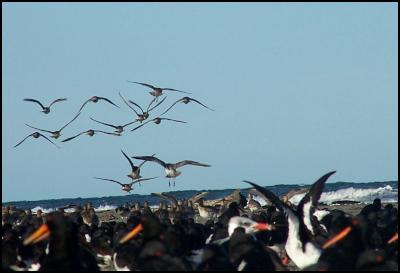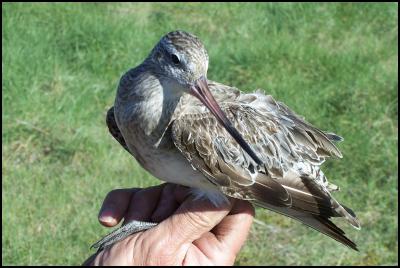Farewell amidst fear for the godwits
Farewell amidst fear for the godwits

Click to enlarge
Farewell amidst
fear for the godwits
Christchurch is getting ready to farewell the steadily declining flock of the bar-tailed godwits on their perilous journey home to Alaska.
Christchurch City Council ranger Andrew Crossland says that the godwit numbers in New Zealand have been declining over the past two decades and believes the godwits may be perishing on their way home due to the loss of feeding grounds in Asia.
“Loss of feeding habitat means that building up fat reserves for the final leg of the migration is becoming increasingly more difficult, and numbers of birds are possibly not making it to Alaska, but may be perishing on 7000 plus kilometre flight between the Yellow Sea and the breeding grounds in Alaska,” says Mr Crossland.
“This makes our treatment of godwits in New Zealand even more important, as it is crucial that they need to set out on their return migration in absolutely peak condition,” he says. “We need to ensure that Godwits always have safe and secure feeding and roosting habitat on our New Zealand estuaries.”

Click to enlarge
Christchurch has adopted the visitors, who fly over 11,000 km non-stop in September to winter at the Avon-Heathcote Estuary (as well as other places in New Zealand) – as harbingers of spring. The godwits arrival for Christchurch on September 9, last year marked the end of one of the coldest winters in the region in many years. The godwits are close to the hearts of Christchurch residents: the Christchurch Cathedral bells peal out a welcome soon after the first of the little long-distance champions touchdown at the Avon-Heathcote Estuary.
“Scientists suspect that habitat destruction along the return migration route (via Asia) is the principal cause of this decline, he says.
“If people want the Bar-tailed Godwit to survive as a species, and to have them coming back to Christchurch and elsewhere every year, then communities need to be proactive in reducing levels of disturbance to these birds,” he says. Much of the disturbance ensues from people with a careless attitude, particularly owners of unleashed dogs.
The godwits spend the summer resting and gaining weight and generally leave in late February or early March for the 17,000 km flight back to their northern hemisphere breeding grounds following a coastal migration route through Asia. On leaving NZ, most Godwits fly directly to the Yellow Sea region of China and Korea where they refuel before continuing on to the breeding grounds in Alaska.
The farewell ceremony will be at the South Shore Spit Reserve (end of Rocking Horse road) on Wednesday at 6 pm.
Table
Annual peak
numbers have trended down from a high of 2350 in 1988 to
just 1390 in 2001. In the last 2 years however, they’ve
been a little higher with a max of 2032 last summer, and a
max so far this summer of 1934.
1988/89 /
2350 / Nov 1988
1989/90 / 2050 / Nov 1989
1990/91 /
1640 / Dec 1990
1991/92 / 2140 / Oct 1991
1992/93 /
2052 / Oct 1992
1993/94 / 2138 / Dec 1993
1994/95 /
1630 / Jan 1995
1995/96 / 1410 / Oct 1995
1996/97 /
1737 / Oct 1996
1997/98 / 1522 / Feb 1998
1998/99 /
1501 / Dec 1998
1999/00 / 1744 / Dec 1999
2001/02 /
1390 / Oct 2001
2002/03 / 1712 / Jan 2003
2003/04 /
1512 / Dec 2003
2004/05 / 1424 / Feb 2005
2005/06 /
1537 / Jan 2006
2006/07 / 1655 / Feb 2007
2007/08 /
2032 / Feb 2008-05-18
2008/09 / 1930 / Jan
2009
ENDS


 Business Canterbury: Urges Council To Cut Costs, Not Ambition For City
Business Canterbury: Urges Council To Cut Costs, Not Ambition For City Wellington Airport: On Track For Net Zero Emissions By 2028
Wellington Airport: On Track For Net Zero Emissions By 2028 Landcare Research: ANZAC Gall Fly Release Promises Natural Solution To Weed Threat
Landcare Research: ANZAC Gall Fly Release Promises Natural Solution To Weed Threat NZ Anti-Vivisection Society: Auckland Rat Lovers Unite!
NZ Anti-Vivisection Society: Auckland Rat Lovers Unite! University of Canterbury: $1.35 Million Grant To Study Lion-like Jumping Spiders
University of Canterbury: $1.35 Million Grant To Study Lion-like Jumping Spiders Federated Farmers: Government Ends War On Farming
Federated Farmers: Government Ends War On Farming



